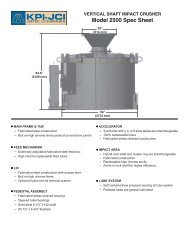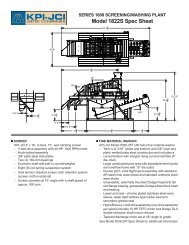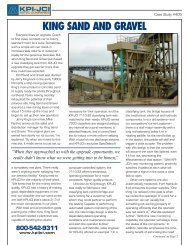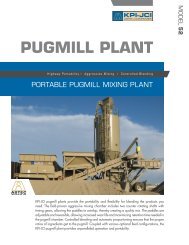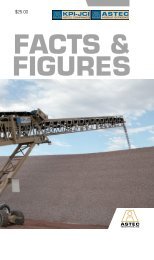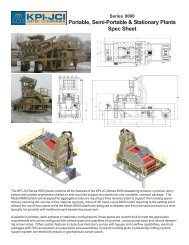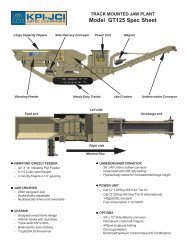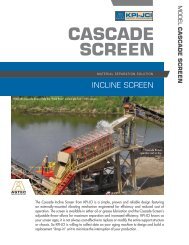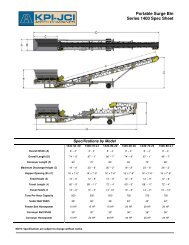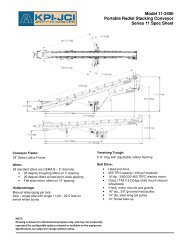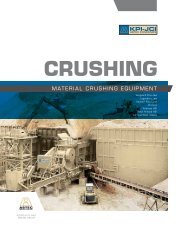Download Today's Aggregate and Mining Solutions - Vol 3 ... - KPI-JCI
Download Today's Aggregate and Mining Solutions - Vol 3 ... - KPI-JCI
Download Today's Aggregate and Mining Solutions - Vol 3 ... - KPI-JCI
- No tags were found...
Create successful ePaper yourself
Turn your PDF publications into a flip-book with our unique Google optimized e-Paper software.
Hydraulic Breaker SizingSelection criteria snapshotThe most critical factor in choosing the appropriate breaker size is consideration of thematerial to be broken. When breaking oversize material, the breaker is expected to breakthe material down quickly into multiple pieces—if the operator has to re-position the breakertowards the edge of the rock <strong>and</strong> gradually downsize the material, production rates slow down.To assess which breaker will effectively h<strong>and</strong>le the application, the size <strong>and</strong> hardness of thematerial must be known. For example, if a 4 cu. yard piece of hard rock (20,000 psi or greater)needs to be broken in half, a 7,500 ft-lb or larger breaker will be required. If a 2 cu. yard piece oflimestone (20,000 or less) needs to be broken in half, a 3,000-5,000 ft-lb breaker will be needed.After considering the type of work, determine the carrier on which the breaker will be installed.If the operating weight of the carrier falls outside of the “Recommended Carrier Weight” rangespecified by the breaker manufacturer, the carriers lifting capacity <strong>and</strong> oil flow will need to beverified to ensure a proper fit. On most carriers, the maximum lifting capacity is lowest when theboom is at full reach (limited by stability or hydraulic force depending on the boom configuration).This is the value that must be compared to the operating weight of the breaker. Required oilflow <strong>and</strong> operating pressure ranges are also specified for each breaker; however, for maximumproductivity, the carrier should be capable of providing the maximum required flow. The oil flowshould be evaluated at operating pressure.SIZING THE BREAKER BASED ON PRODUCTION RATESBTI has recently introduced a complete newline-up of hydraulic breakers; the BX Series witha range of 400-4,000 ft-lbs <strong>and</strong> the BXR Serieswith a range from 5,000 ft-lb to a whopping16,000 ft-lb—one of the biggest in the industry.MAXIMIZE PRODUCTION AND MINIMIZE COSTSBTI’s BXR Series uses recoil sensing technology with operator actuated two-speed control <strong>and</strong> an oversized piston. This combination maximizesblow energy <strong>and</strong> bpm’s under varying rock conditions. For example, in hard rock conditions, the bpm’s are increased providing up to 80 percentoperating efficiency versus 50 percent efficiency of a conventional breaker:Excavator20 metric tonne/44,100 lb.Breaker Model TB980 BXR50ft-lb class 4,500 5,000gpm 55 54psi 2,600 2,760Efficiency 50% 80%Horsepower applied to the rock 41 64Increasedhorsepowerto the rock =higherproductionWantmore?For more information on breaker selection <strong>and</strong> detailed specifications, contact Breaker Technology Directorof International Sales Robert McArthur at bmcarthur@rockbreaker.com, call 519.599.2015, or Director ofUS Sales Tom Witt at twitt@rockbreaker.com, call 951.369.8281, or visit www.rockbreaker.com.Today’s aggregate & mining solutions | volume 3, number 1 33



